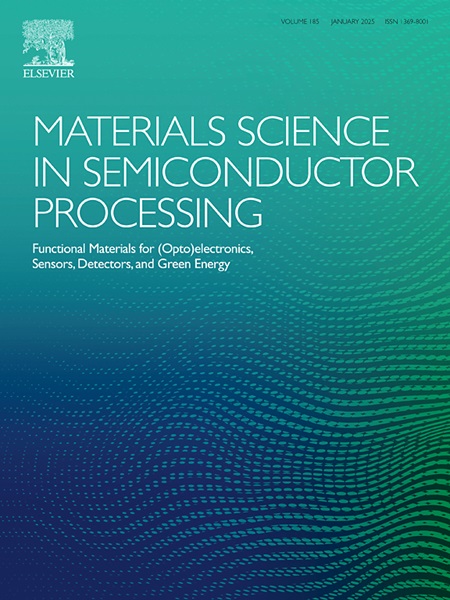A room temperature ZnO:Ga NWs&NSs/MEMS H2S gas sensor
IF 4.6
3区 工程技术
Q2 ENGINEERING, ELECTRICAL & ELECTRONIC
引用次数: 0
Abstract
This study uses nanotechnology, MEMS technology and doping technology to produce a room temperature ZnO:Ga H2S gas sensor with a nanowires hybrid nanosheets (NWs&NSs) structure. ZnO:Ga NWs&NSs is fabricated by adding gallium nitrate hydrate (GNH) to an aqueous solution to grow ZnO nanowires (NWs). The results for SEM show that ZnO NWs grow on the sensing material but e non-IDE regions have a nanosheet structure. EDS results show that Ga element is almost doped in the ZnO nanosheets. XRD analysis shows that the diffraction peaks for the ZnO:Ga NWs&NSs are attributed to lanes of the Wurtzite hexagonal. In terms of the gas sensing characteristics of the ZnO:Ga NWs&NSs/MEMS sensor, it has a greater sensor response than a ZnO NWs/MEMS and a ZnO thin film/MEMS gas sensor at room temperature with a H2S concentration of 0.8 ppm. The average response time is 22.4 s and the recovery time is 16.8 s for a ZnO:Ga NWs&NSs/MEMS gas sensor that operates at room temperature with a 0.4 ppm H2S ambiance. The ZnO:Ga NWs&NSs/MEMS gas sensor is also less sensitive to CO, CO2, H2 and SO2. These experimental results show the ZnO:Ga NWs&NSs/MEMS H2S gas sensor is stable, reproducible and selective.
室温 ZnO:Ga NWs&NSs/MEMS H2S 气体传感器
本研究利用纳米技术、微机电系统技术和掺杂技术制备了一种具有纳米线混合纳米片(NWs&NSs)结构的室温 ZnO:Ga H2S 气体传感器。ZnO:Ga NWs&NSs 是通过在水溶液中加入硝酸镓水合物(GNH)来生长 ZnO 纳米线(NWs)而制成的。扫描电子显微镜(SEM)结果表明,ZnO 纳米线生长在传感材料上,但非IDE 区域具有纳米片状结构。EDS 结果显示,氧化锌纳米片中几乎掺杂了镓元素。XRD 分析表明,ZnO:Ga NWs&NSs 的衍射峰归因于渥兹六方的车道。就 ZnO:Ga NWs&NSs/MEMS 传感器的气体传感特性而言,在室温条件下,当 H2S 浓度为 0.8 ppm 时,它比 ZnO NWs/MEMS 和 ZnO 薄膜/MEMS 气体传感器具有更高的传感响应。ZnO:Ga NWs&NSs/MEMS 气体传感器在室温和 0.4 ppm H2S 环境中工作时,平均响应时间为 22.4 秒,恢复时间为 16.8 秒。ZnO:Ga NWs&NSs/MEMS 气体传感器对 CO、CO2、H2 和 SO2 的敏感度也较低。这些实验结果表明,ZnO:Ga NWs&NSs/MEMS H2S 气体传感器具有稳定性、可重复性和选择性。
本文章由计算机程序翻译,如有差异,请以英文原文为准。
求助全文
约1分钟内获得全文
求助全文
来源期刊

Materials Science in Semiconductor Processing
工程技术-材料科学:综合
CiteScore
8.00
自引率
4.90%
发文量
780
审稿时长
42 days
期刊介绍:
Materials Science in Semiconductor Processing provides a unique forum for the discussion of novel processing, applications and theoretical studies of functional materials and devices for (opto)electronics, sensors, detectors, biotechnology and green energy.
Each issue will aim to provide a snapshot of current insights, new achievements, breakthroughs and future trends in such diverse fields as microelectronics, energy conversion and storage, communications, biotechnology, (photo)catalysis, nano- and thin-film technology, hybrid and composite materials, chemical processing, vapor-phase deposition, device fabrication, and modelling, which are the backbone of advanced semiconductor processing and applications.
Coverage will include: advanced lithography for submicron devices; etching and related topics; ion implantation; damage evolution and related issues; plasma and thermal CVD; rapid thermal processing; advanced metallization and interconnect schemes; thin dielectric layers, oxidation; sol-gel processing; chemical bath and (electro)chemical deposition; compound semiconductor processing; new non-oxide materials and their applications; (macro)molecular and hybrid materials; molecular dynamics, ab-initio methods, Monte Carlo, etc.; new materials and processes for discrete and integrated circuits; magnetic materials and spintronics; heterostructures and quantum devices; engineering of the electrical and optical properties of semiconductors; crystal growth mechanisms; reliability, defect density, intrinsic impurities and defects.
 求助内容:
求助内容: 应助结果提醒方式:
应助结果提醒方式:


